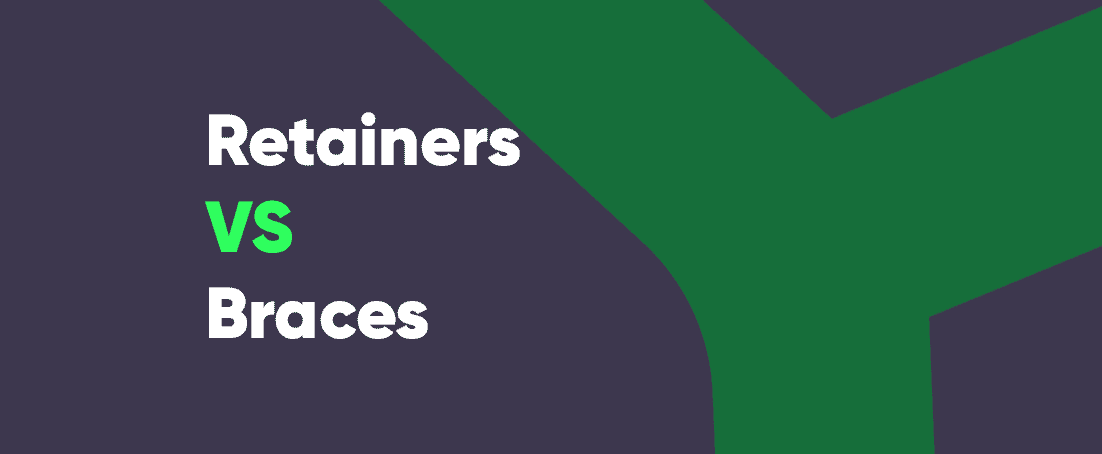Many people assume retainers and braces, especially invisible braces, are similar. However, braces and retainers serve distinct purposes. Picking the right dental tool is crucial – it’s like choosing the correct tool for the job.
Braces act as tooth-shifters, gently moving them into place with steady pressure. Retainers, however, serve as teeth position guardians, preventing your newly aligned smile from any unwanted shifting.
Misinterpreting the functions of braces and retainers or neglecting their proper usage can result in oral health issues. It also compromises the desired outcomes of orthodontic treatment. Let’s clear up the confusion and make smart decisions to keep your oral health in check.
Table of Contents:
What are Braces?
Braces are dental tools, specializing in gradually shifting your teeth to straighten them. Made up of metal or ceramic brackets bonded to your teeth, braces are connected by wires that gently but persistently apply pressure. This remodels your bone, guiding your teeth into their ideal positions over time. Braces tackle dental issues such as crooked teeth, crowded mouths, and bite issues.
Regular adjustments are an essential part of successful dental treatment with braces. As your teeth move, the wires and brackets in your braces can loosen or become less effective. Adjustments ensure that the pressure on your teeth stays consistent, keeping the movement on track.
Types of Braces
Different types of braces cater to specific needs. Here’s a brief overview of each type of braces:
- Traditional Metal Braces: Common stainless steel braces.
- Ceramic Braces: Less visible, made from clear or tooth-colored materials.
- Lingual Braces: Placed on the back, invisible from the front.
- Self-ligating Braces: Utilize a built-in system for archwire stability.
- Clear Aligners: Invisalign, nearly invisible plastic shells, gradually reposition teeth.
- At-home Invisible Braces: Custom aligners, offering flexibility with a fast treatment time.
At-home invisible braces present a convenient solution. Choosing the best aligners is the key to effectively resolving mild to moderate orthodontic issues, ensuring precision, comfort, and efficient results.
Worn for 20 to 22 hours daily, these clear aligners offer flexibility and inconspicuous teeth straightening. Passive aligners, including Invisalign and Byte passive aligners, serve as retainers post-treatment. While other aligners in the series actively move teeth towards their desired positions, passive aligners act as placeholders.
| Byte Aligners |
|
When do you Need Braces?
Braces, including traditional metal and clear aligners, effectively address various orthodontic concerns. Traditional metal braces handle severely crooked or crowded teeth, underbite, overbite, crossbite, open bite, and spacing issues. Clear aligners are ideal for mild to moderate dental adjustments, fixing spacing problems, and gently realigning lower teeth.
Consultation with an orthodontist determines eligibility, with braces typically prescribed during childhood or early adolescence, but increasingly embraced by adults seeking effective orthodontic solutions.
What are Retainers?
Retainers are dental tools used to secure your straightened smile! These custom-made devices, typically of acrylic or clear plastic, gently encase your teeth, preventing them from drifting back to their old positions.
Think of them as memory keepers of your orthodontic treatment, whether braces, aligners, or even surgery. They work by applying gentle pressure to hold your teeth in place while your bones and tissues adjust to their new alignment.
Made from molds of your teeth, they’re snug but comfy, and usually worn full-time for a few months after treatment, gradually transitioning to nighttime wear for lasting results.
Types of Retainers
Choosing the right retainer type depends on your specific needs and preferences. Consult your dentist or orthodontist for personalized advice. When it comes to retainer types, you have two options:
Removable Retainers:
- Hawley retainer: The classic metal-and-acrylic combo, offering durability and affordability.
- Essix retainers: Clear plastic and virtually invisible, perfect for a discreet option. Retainers from clear aligner brands including Byte, Candid, and Remi retainers serve as final tools to hold teeth in place after orthodontic treatment, preventing them from shifting back to their original positions.
Permanent Retainers:
Also known as bonded or fixed retainers, permanent retainer is a thin wire glued to the back of your lower front teeth for added stability.
| Remi retainers |
|
When do you Need Retainers?
You need retainers after orthodontic treatment (braces, aligners, or surgery) to prevent your teeth from rebelling and shifting back to their old positions. They’re essential to maintain the achieved alignment. Regular wear is typically required initially, gradually transitioning to nighttime use.
Individuals of any age may need retainers, and orthodontists recommend starting their use immediately after braces removal to ensure long-lasting results. Consistent wear of retainers is vital to ensure the results of your dental treatment are preserved.
Retainer Vs Braces: Comparison
When it comes to straightening your smile, braces and retainers are two key players. While both are orthodontic tools, they work in vastly different ways. Let’s untangle their roles and help you understand which one you might need.
Function:
- Braces: They actively move misaligned teeth into their desired positions through constant pressure applied by brackets and wires. They tackle complex problems like overbites, underbites, and severe crowding.
- Retainers: They maintain the results achieved with braces or other treatments. They gently hold teeth in place while surrounding tissues adapt to the new alignment.
Maintenance:
- Braces: Regular adjustments and professional cleaning are crucial, as food particles get trapped in metal components of braces. However, cleaning aligners is easier. You can simply brush your removable clear aligners with a soft toothbrush and clear, unscented soap, then rinse thoroughly with cool water. Food restrictions and potential discomfort due to brackets and wires are also realities.
- Retainers: Removable retainers require cleaning with toothpaste and water, while fixed retainers may need professional assistance. Generally, retainer maintenance is minimal as compared to braces.
Comfort:
- Braces: Can cause initial discomfort and irritation. Initial discomfort from metal braces is due to the hardware, while aligners pain is due to the initial adjustment period. Speech may be affected, and certain foods are off-limits.
- Retainers: Usually more comfortable than braces, especially removable options. Some may experience slight lisping initially.
Treatment Process and Duration:
- Braces: Wear time varies depending on complexity, typically ranging from months to years. Requires regular adjustments and monitoring by an orthodontist.
- Retainers: Worn full-time for several months after treatment, transitioning to nighttime wear for long-term maintenance. Relatively minimal follow-up appointments are needed for retainer treatment.
Materials:
- Braces: Metal, ceramic, or a combination. Removable clear aligners are made of medical grade plastic.
- Retainers: Plastic, metal, or a combination. Typically custom-made from molds of your teeth.
Retainer Vs Braces: Pricing Differences
Retainers generally range from $150 to $1,000, with permanent retainers around $250 and replacements varying from $150 to $500. They are less expensive than braces as dental treatment is completed and retainer maintenance is relatively low-cost.
In comparison, braces can cost between $3,000 and $10,000. They are generally more expensive due to longer treatment, materials, and frequent appointments.
While retainers represent a smaller upfront investment, considering long-term benefits and potential replacement costs is crucial. Braces involve a higher initial expense but may not require ongoing replacements, impacting overall costs differently.
By evaluating individual orthodontic needs and budgets, patients can discuss financial aspects with their orthodontist to make an informed and cost-effective choice.
Are Retainers Better Than Braces?
Retainers vs Braces is not a competition about “better,” but about choosing the right tool for the job!
Braces actively move teeth to correct bite issues and misalignments. They’re ideal for complex dental cases. Retainers, on the other hand, hold teeth in their newly straightened positions after braces come off. They prevent teeth from drifting back to their old misaligned positions.
Thinking “retainers are better” is a common misconception. They’re not substitutes for braces! Each plays a crucial role in achieving a beautiful, healthy smile. An orthodontist, with their years of experience in dentistry, can assess your specific needs and recommend the perfect solution, whether it’s braces for major adjustments or retainers to preserve your straightened smile.
Can You Get a Retainer Instead of Braces?
No, you can’t just skip braces and go straight for retainers. It’s a common misconception that they’re interchangeable, but they have completely different jobs!
Think of braces as sculptors: they actively move teeth into their desired positions using brackets and wires. This is crucial for correcting major bite issues and misalignments like overbites, underbites, and severe dental crowding.
Retainers, on the other hand, are like security guards: they gently hold teeth in place after they’ve already been straightened by braces or other treatments. They prevent your teeth from “rebelling” and shifting back to their original positions. If you have significant orthodontic issues, braces are the only way to address them effectively.
Retainer Vs Braces: Conclusion
Remember, braces are architects shaping your smile, while retainers are loyal guards protecting it. Choosing the right dental tool – braces for big shifts and retainers for holding the teeth positions steady – ensures a beautiful, long-lasting smile for years to come! Consult your orthodontist for expert guidance on your journey to a confident grin.

